Developing Intensity-Duration-Frequency (IDF) Curves Based on Rainfall Cumulative Distribution Frequency (CDF) for Can Tho City, Vietnam
Abstract
:1. Introduction
2. Materials and Methods
- Rainfall intensity (i, q), is the amount of rain falling per unit area in a unit of time. Rainfall intensity can be in the form of accumulative rainfall depth (i.e., mm/min, cm/h) or rainfall volume (q, L/s.ha) and is shown to be related by the formula q = 166.7i.
- Design rainfall time step (period, t), is the amount of rainfall in the calculation period (15 min or 30 min) assuming that the intensity does not change.
- Rainfall return period or frequency (N, years): is the time in years for the reappearance of rainfall of the equal amount (or greater than that of design intensity). The larger the rainfall, the less frequent it will occur (in case P ≤ 50%).
2.1. Development of the IDF Rainfall Curve Using Empirical Formula
2.2. Selecting the Most Suitable IDF Rainfall Curve for Can Tho City
3. Results and Discussion
3.1. Various Rainfall Intensity Duration Assessments
3.2. Developing an IDF Rainfall Curve Based on CDF Rainfall Curve
3.3. Development of IDF Rainfall Curve from Empirical Formulas According to the Vietnamese Standard (TCVN 7957:2008), the Department of Hydrology, and the Ministry of Transport
3.4. The IDF Rainfall Built from Empirical Formulas That Have Been Used in Some Asian Countries
3.5. Compareration the Selection of IDF Curves for the Study Area
4. Conclusions
Author Contributions
Funding
Institutional Review Board Statement
Informed Consent Statement
Data Availability Statement
Acknowledgments
Conflicts of Interest
Appendix A
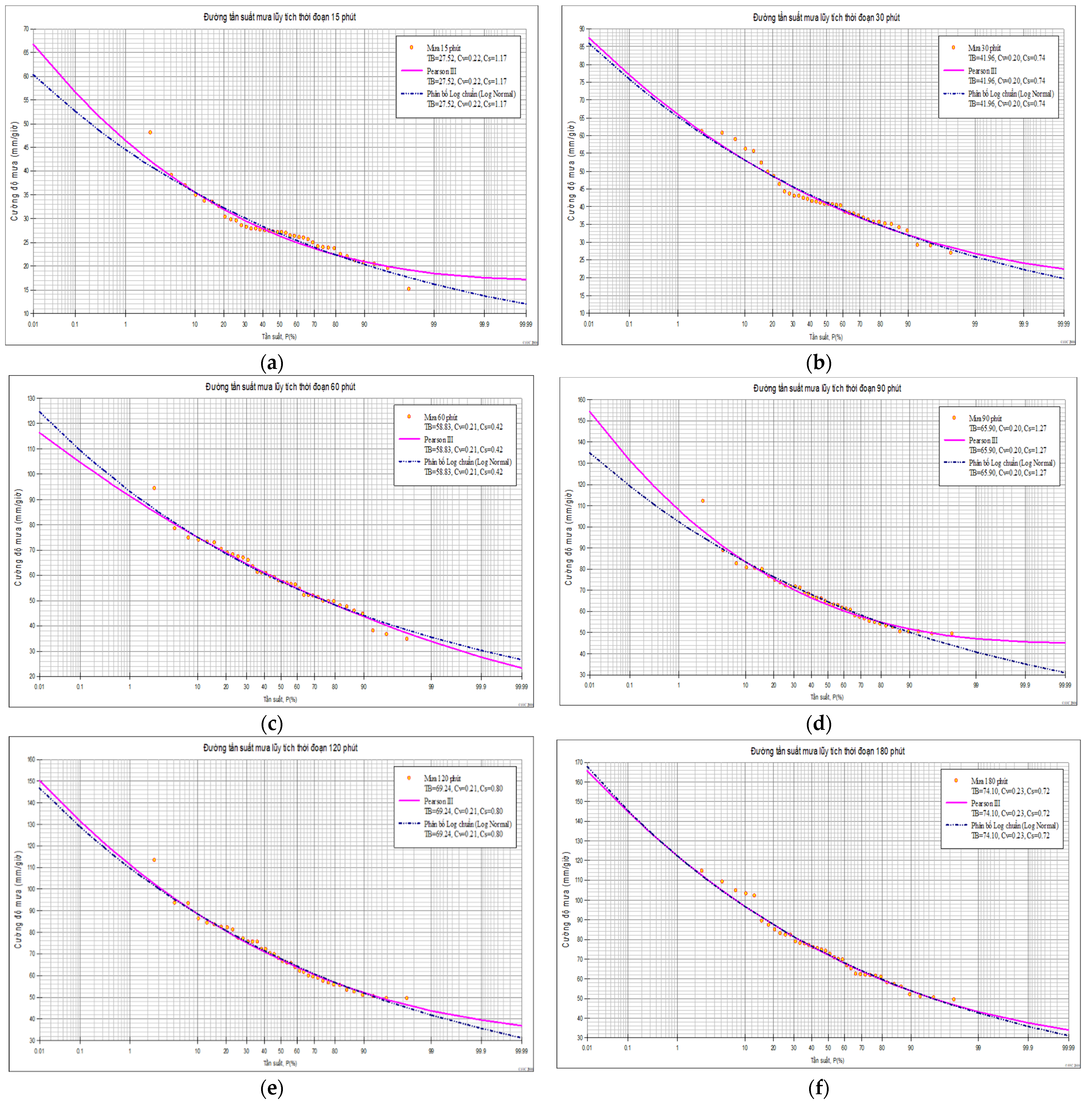
References
- Nguyen, Q.; Thi Thao Nhi, P.; Nguyen Khoi, D. Developing IDF Curve of Extreme Rainfall at Tan Son Hoa Station for the Period 1980–2015. Sci. Technol. Dev. J.-Sci. Earth Environ. 2017, 1, 73–81. [Google Scholar] [CrossRef]
- Zhao, W.; Kinouchi, T.; Nguyen, H.Q. A Framework for Projecting Future Intensity-Duration-Frequency (IDF) Curves Based on CORDEX Southeast Asia Multi-Model Simulations: An Application for Two Cities in Southern Vietnam. J. Hydrol. 2021, 598, 126461. [Google Scholar] [CrossRef]
- Meyer, A.F. The Elements of Hydrology; Wiley: New York, NY, USA, 1917. [Google Scholar]
- Sherman, C.W. Frequency and Intensity of Excessive Rainfalls at Boston, Massachusetts. Trans. Am. Soc. Civ. Eng. 1931, 95, 951–960. [Google Scholar] [CrossRef]
- Bernard, M.M. Formulas for Rainfall Intensities of Long Duration. Trans. Am. Soc. Civ. Eng. 1932, 96, 592–606. [Google Scholar] [CrossRef]
- Hershfield, D.M. Estimating the Probable Maximum Precipitation. Trans. Am. Soc. Civ. Eng. 1963, 128, 534–551. [Google Scholar] [CrossRef]
- Chen, C. Rainfall Intensity-Duration-Frequency Formulas. J. Hydraul. Eng. 1983, 109, 1603–1621. [Google Scholar] [CrossRef]
- Di Baldassarre, G.; Brath, A.; Montanari, A. Reliability of Different Depth-duration-frequency Equations for Estimating Short-duration Design Storms. Water Resour. Res. 2006, 42. [Google Scholar] [CrossRef]
- Nhat, L.M.; Tachikawa, Y.; Takara, K. Establishment of Intensity-Duration-Frequency Curves for Precipitation in the Monsoon Area of Vietnam. Annu. Disaster Prev. Res. Inst. 2006, 49, 93–103. [Google Scholar]
- Kim, J.-W.; Nam, W.-S.; Shin, J.-Y.; Heo, J.-H. Regional Frequency Analysis of South Korean Rainfall Data Using FORGEX Method. J. Korea Water Resour. Assoc. 2008, 41, 405–412. [Google Scholar] [CrossRef] [Green Version]
- Al Mamoon, A.; Joergensen, N.E.; Rahman, A.; Qasem, H. Derivation of New Design Rainfall in Qatar Using L-Moment Based Index Frequency Approach. Int. J. Sustain. Built Environ. 2014, 3, 111–118. [Google Scholar] [CrossRef] [Green Version]
- Elsebaie, I.H. Developing Rainfall Intensity–Duration–Frequency Relationship for Two Regions in Saudi Arabia. J. King Saud Univ.-Eng. Sci. 2012, 24, 131–140. [Google Scholar] [CrossRef] [Green Version]
- De Paola, F.; Giugni, M.; Topa, M.E.; Bucchignani, E. Intensity-Duration-Frequency (IDF) Rainfall Curves, for Data Series and Climate Projection in African Cities. SpringerPlus 2014, 3, 133. [Google Scholar] [CrossRef] [PubMed] [Green Version]
- Femin, C.V.; Varija, K. Identification of the Best-Fit Probability Distribution and Modeling Short-Duration Intensity-Duration-Frequency Curves—Mangalore. In Trends in Civil Engineering and Challenges for Sustainability; Springer: Singapore, 2021; pp. 765–783. [Google Scholar]
- Schardong, A.; Simonovic, S.P.; Gaur, A.; Sandink, D. Web-Based Tool for the Development of Intensity Duration Frequency Curves under Changing Climate at Gauged and Ungauged Locations. Water 2020, 12, 1243. [Google Scholar] [CrossRef]
- Dang, T.A. Simulating Rainfall IDF Curve for Flood Warnings in the Ca Mau Coastal Area under the Impacts of Climate Change. Int. J. Clim. Chang. Strateg. Manag. 2020, 12, 705–715. [Google Scholar] [CrossRef]
- Kite, G.W. Frequency and Risk Analysis in Hydrology; Water Resources Publications, LLC: Littleton, CO, USA, 1977. [Google Scholar]
- Tuan, L.A. Comparison of Frequency Density Distribution Functions Used in Rainfall Calculation in the Mekong Delta. Master’s Thesis, Asian of Institute of Technology (AIT), Khlong Nueng, Thailand, 1999. [Google Scholar]
- Anh, L.T. Evaluation of Design Flood Calculation Results by Different Frequency Distribution Curves. VNU Sci. J. Nat. Sci. Technol. 2015, 31, 1–5. [Google Scholar]
- TCVN 7957:2008; Drainage and Sewerage-External Networks and Facilities-Design Standard 2008. Vietnam Standard and Quality Institute: Hanoi, Vietnam, 2008.
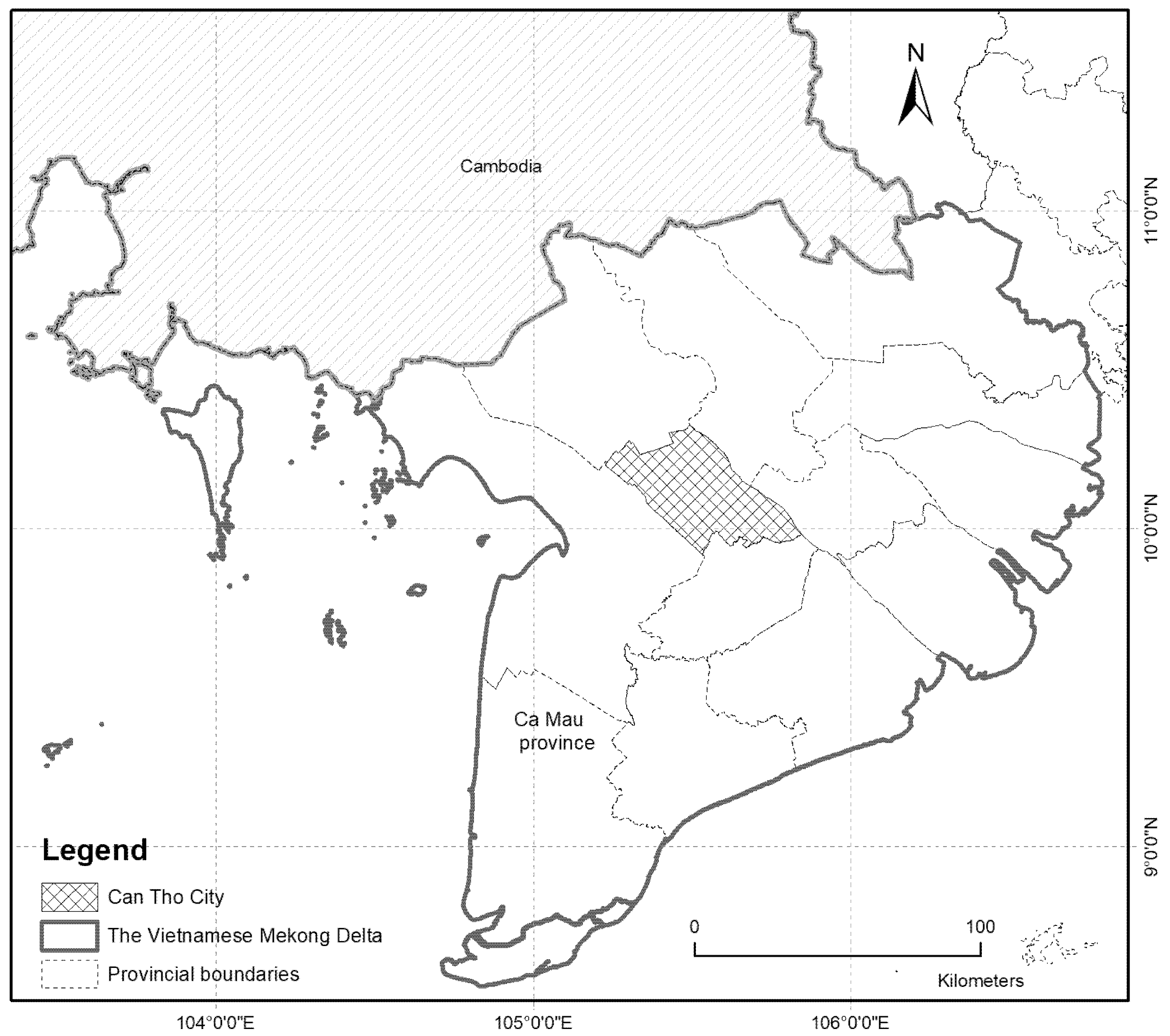

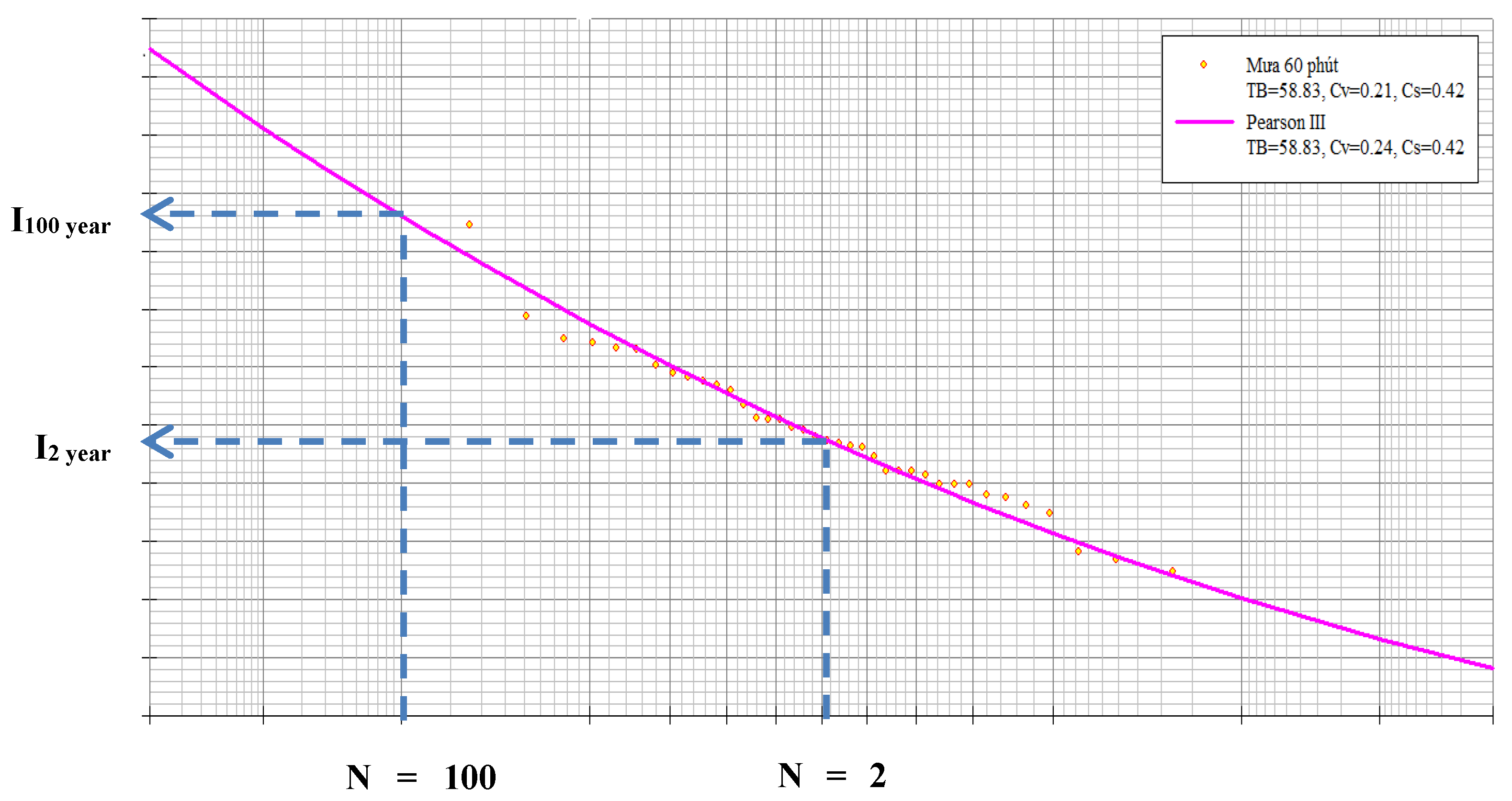
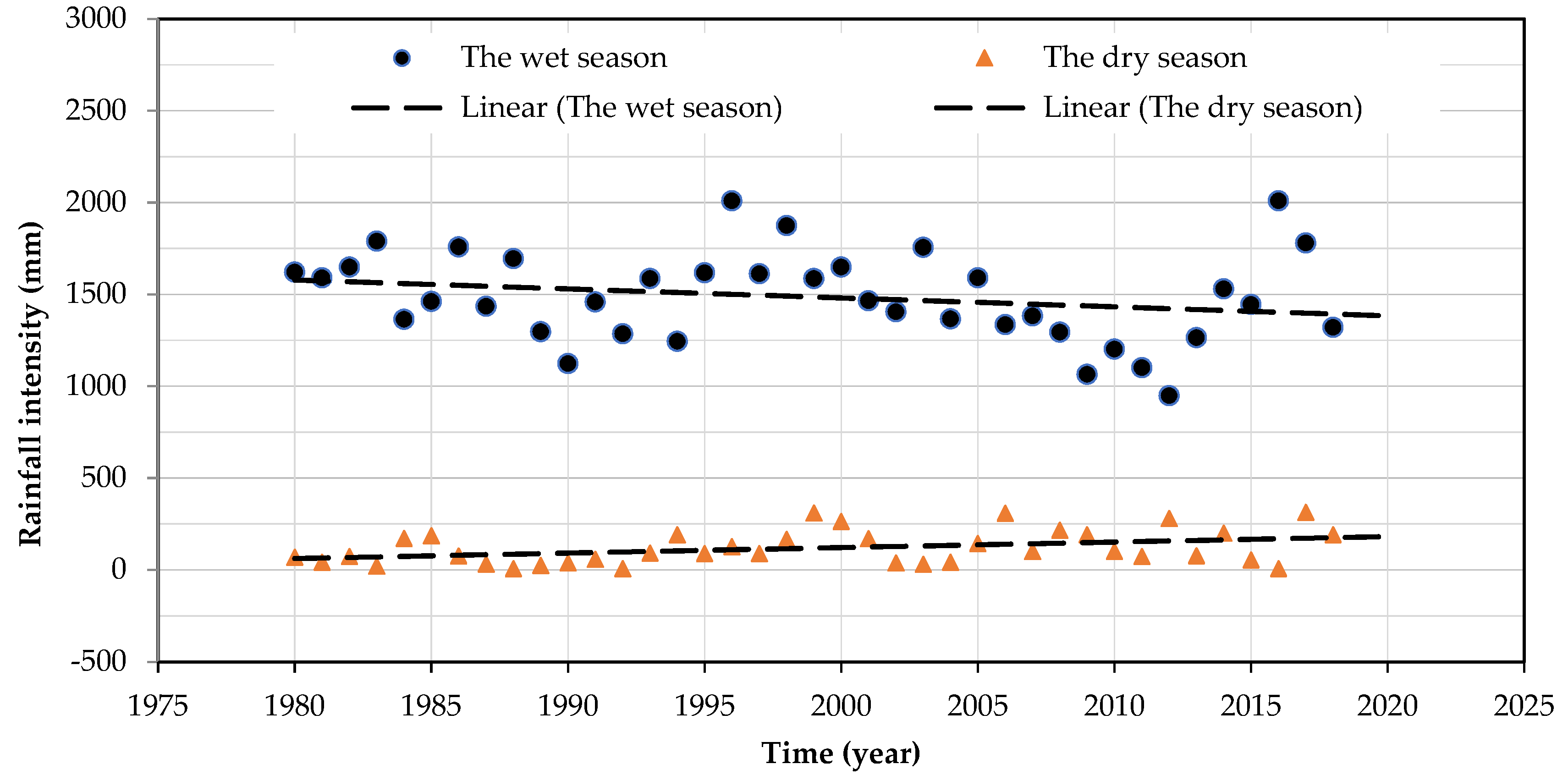
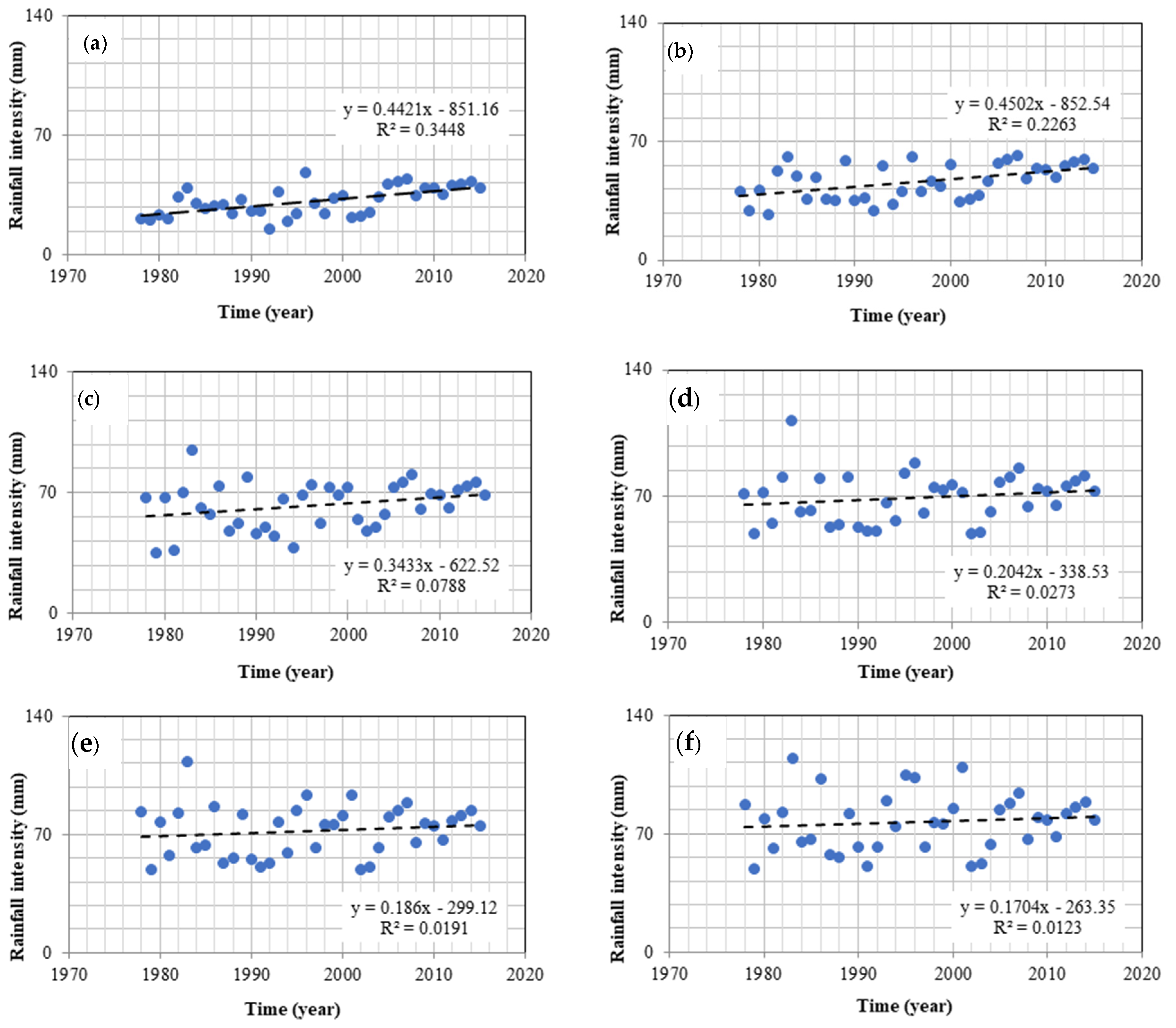

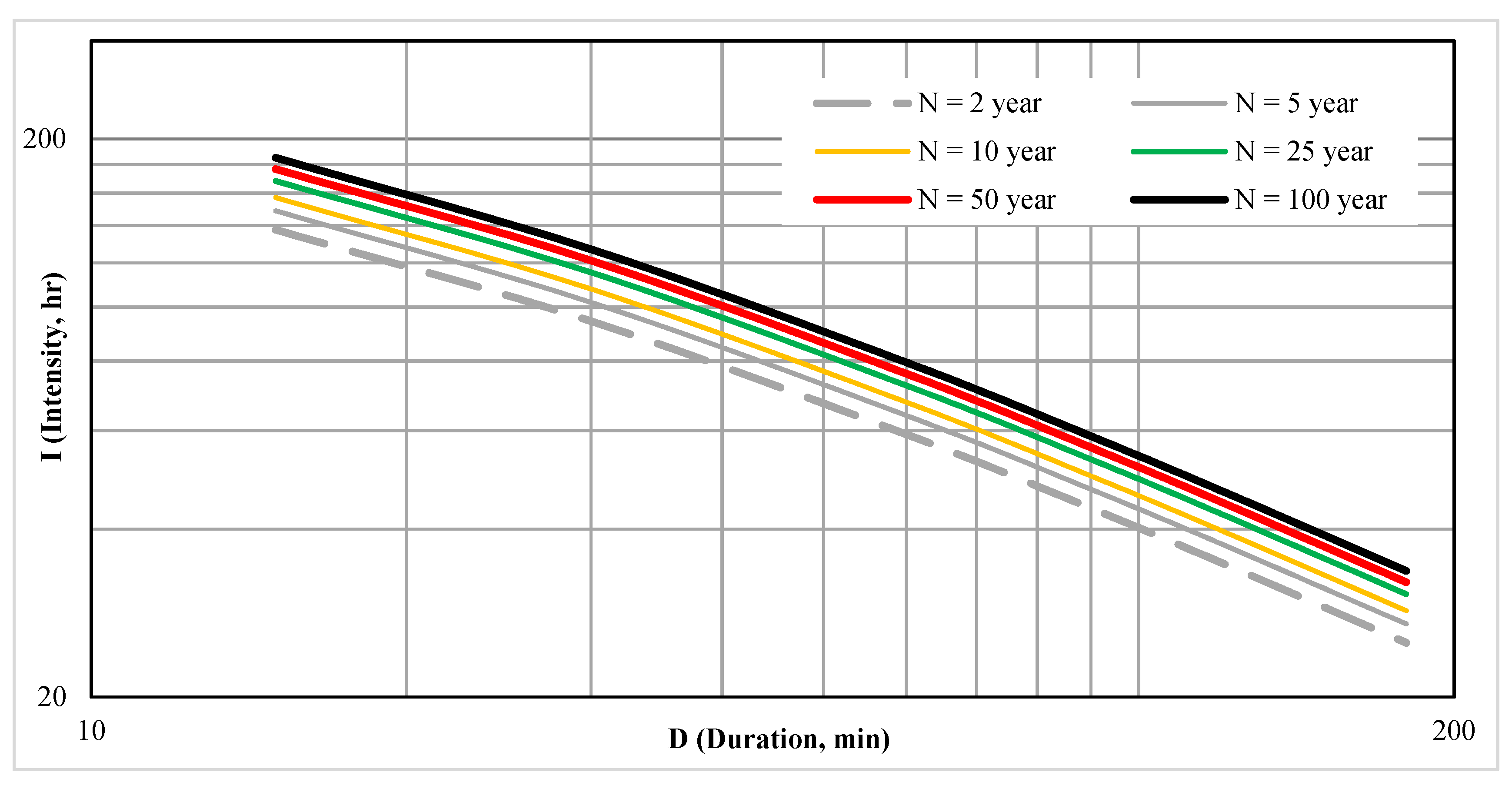
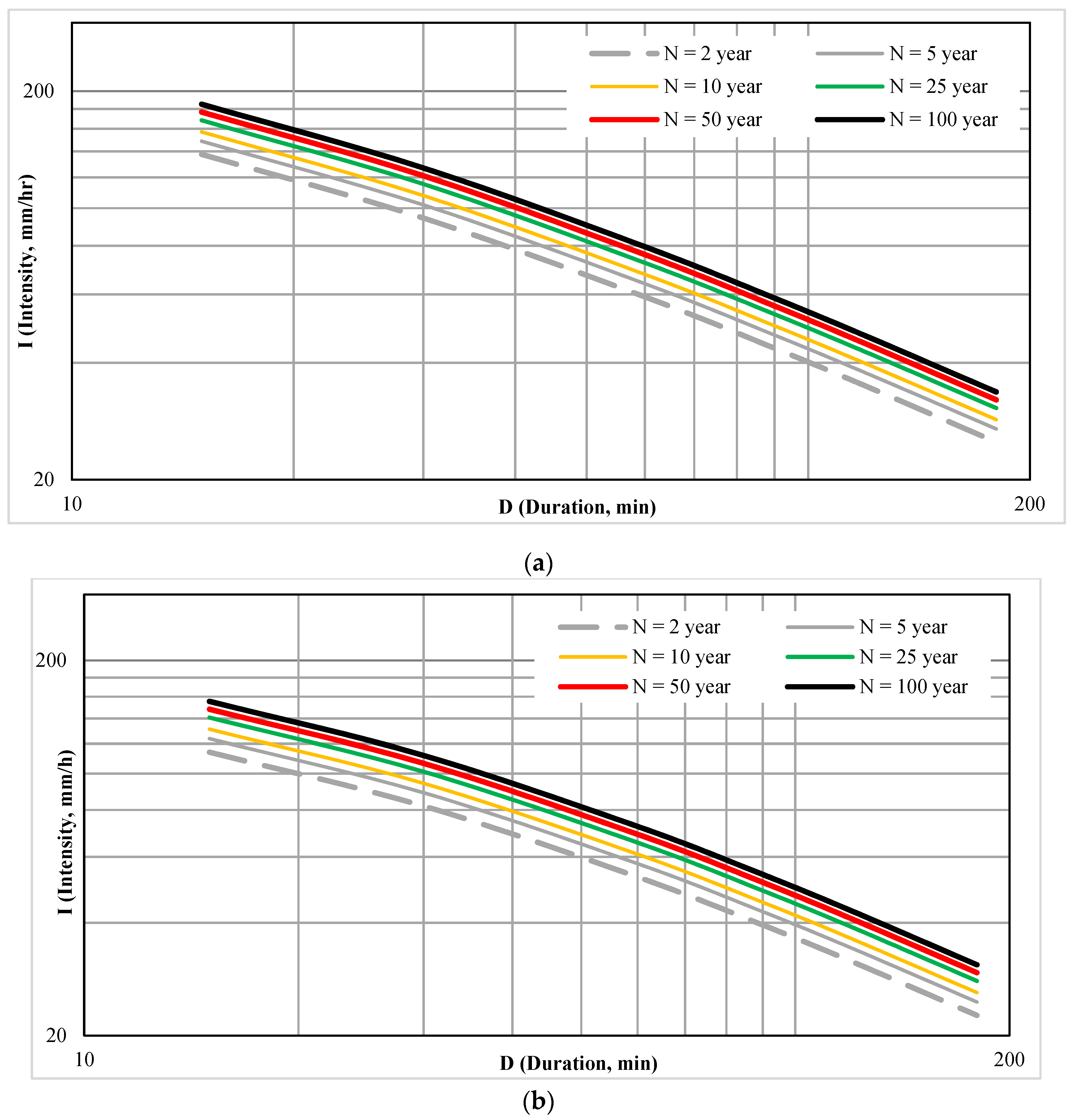
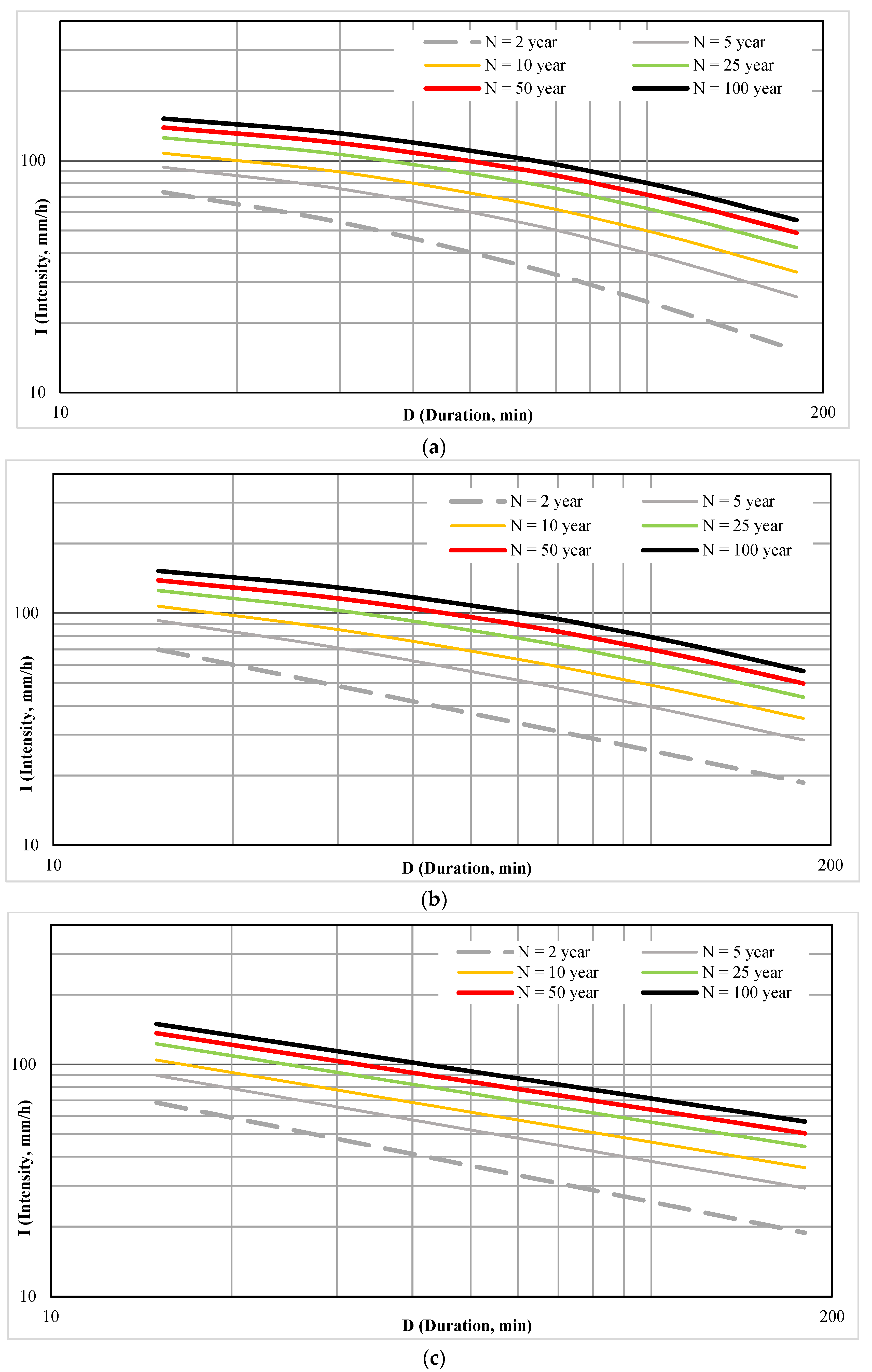
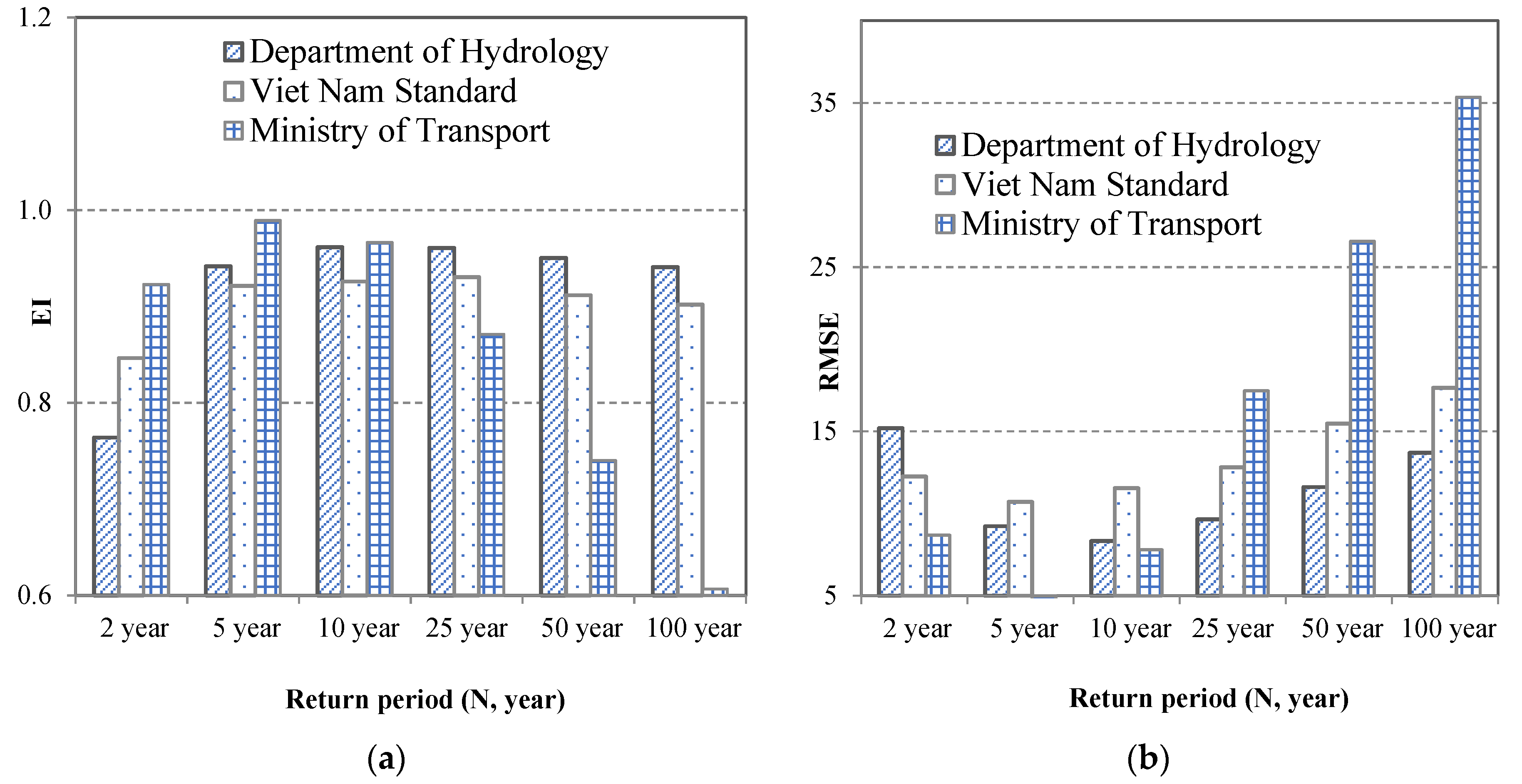
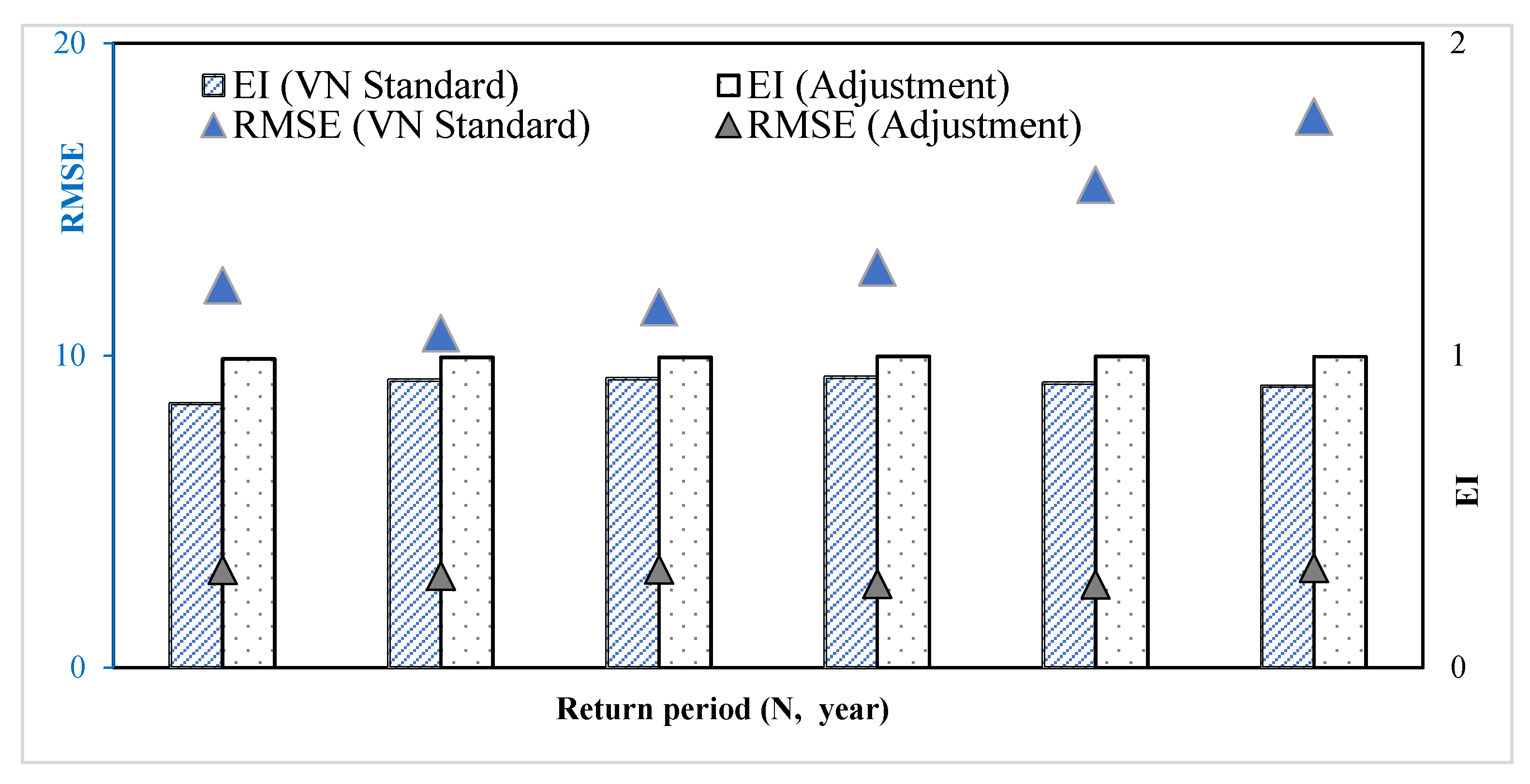
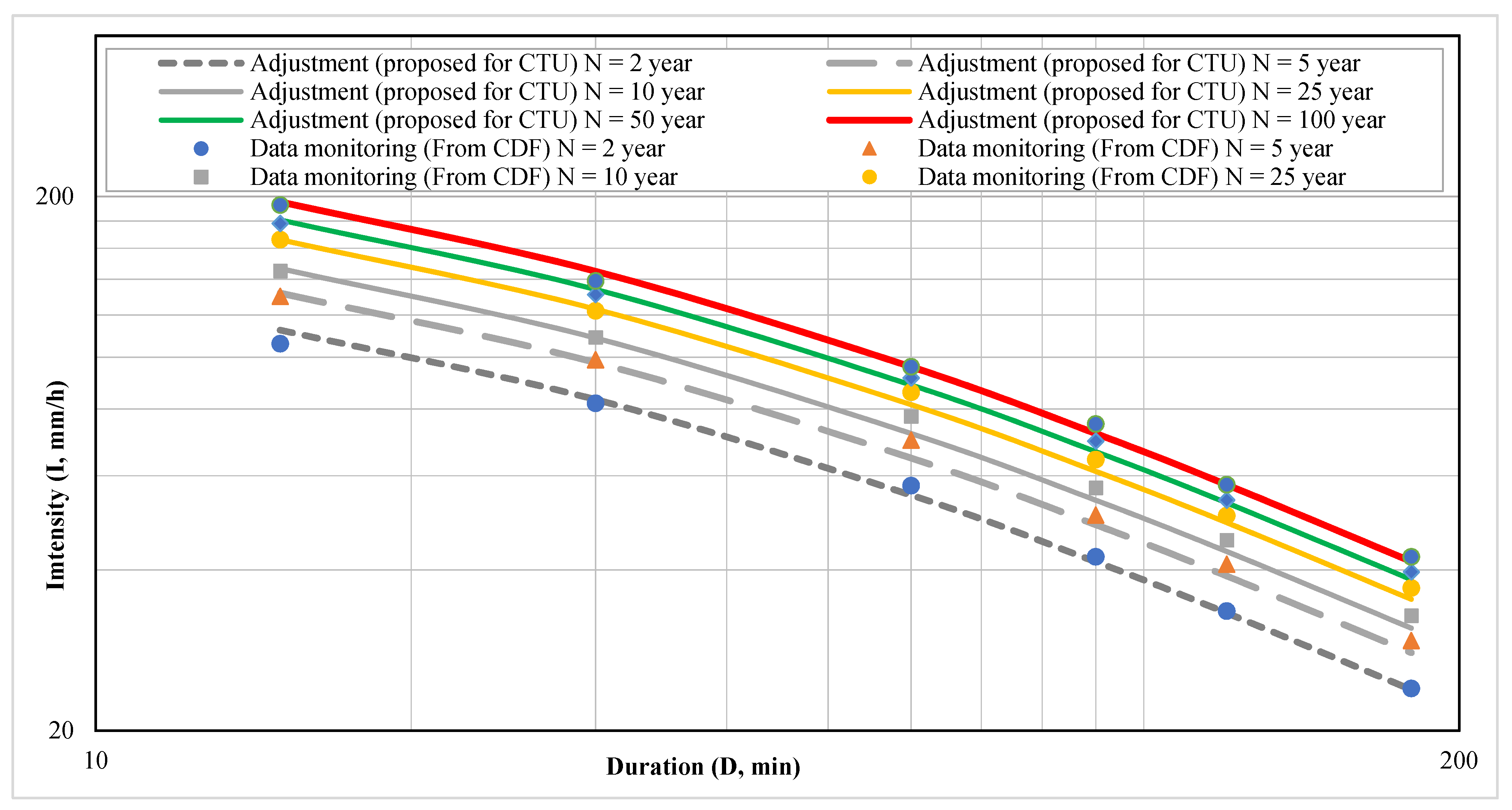
| Rainfall Duration (Min) | Cv | Rainfall Duration (Min) | Cv | ||
|---|---|---|---|---|---|
| 15 | 0.22 | 3.55 | 90 | 0.20 | 3.25 |
| 30 | 0.20 | 3.32 | 120 | 0.21 | 3.42 |
| 60 | 0.21 | 3.46 | 180 | 0.23 | 3.73 |
| Return Period (N, year) | EI | RMSE | ||||
|---|---|---|---|---|---|---|
| Talbot | Kimijima | Bermard | Talbot | Kimijima | Bermard | |
| 2 year | 0.43 | 0.31 | 0.27 | 23.7 | 25.9 | 26.6 |
| 5 year | 0.70 | 0.64 | 0.54 | 21.1 | 22.9 | 26.0 |
| 10 year | 0.78 | 0.75 | 0.65 | 19.7 | 21.2 | 25.1 |
| 25 year | 0.83 | 0.82 | 0.74 | 19.9 | 20.8 | 25.0 |
| 50 year | 0.86 | 0.85 | 0.79 | 19.4 | 20.0 | 23.8 |
Publisher’s Note: MDPI stays neutral with regard to jurisdictional claims in published maps and institutional affiliations. |
© 2022 by the authors. Licensee MDPI, Basel, Switzerland. This article is an open access article distributed under the terms and conditions of the Creative Commons Attribution (CC BY) license (https://creativecommons.org/licenses/by/4.0/).
Share and Cite
Minh, H.V.T.; Lavane, K.; Lanh, L.T.; Thinh, L.V.; Cong, N.P.; Ty, T.V.; Downes, N.K.; Kumar, P. Developing Intensity-Duration-Frequency (IDF) Curves Based on Rainfall Cumulative Distribution Frequency (CDF) for Can Tho City, Vietnam. Earth 2022, 3, 866-880. https://doi.org/10.3390/earth3030050
Minh HVT, Lavane K, Lanh LT, Thinh LV, Cong NP, Ty TV, Downes NK, Kumar P. Developing Intensity-Duration-Frequency (IDF) Curves Based on Rainfall Cumulative Distribution Frequency (CDF) for Can Tho City, Vietnam. Earth. 2022; 3(3):866-880. https://doi.org/10.3390/earth3030050
Chicago/Turabian StyleMinh, Huynh Vuong Thu, Kim Lavane, Le Thi Lanh, Lam Van Thinh, Nguyen Phuoc Cong, Tran Van Ty, Nigel K. Downes, and Pankaj Kumar. 2022. "Developing Intensity-Duration-Frequency (IDF) Curves Based on Rainfall Cumulative Distribution Frequency (CDF) for Can Tho City, Vietnam" Earth 3, no. 3: 866-880. https://doi.org/10.3390/earth3030050









